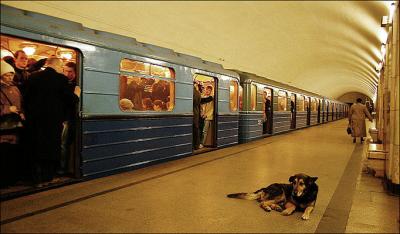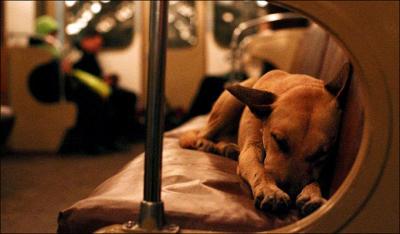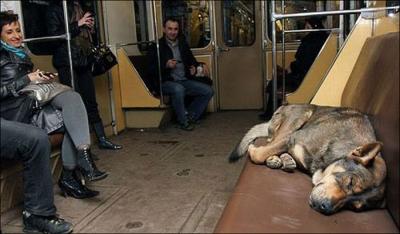I love dogs. My sister
found this article about dogs in Moscow. Smart little buggers. I wish I
could train my Bulldog to take the MTR into town and pick me up some
food.Moscow
Dogs
Dogs are allowed on
public transport in
all of Europe, but
generally with their master. This is even more
interesting. Canine commuter ...Wild
dog waits on the
platform!!STRAY dogs are commuting to and from a city centre on underground trains
in search of food scraps.
Canine commuter ...Wild
dog waits on the
platform!!STRAY dogs are commuting to and from a city centre on underground trains
in search of food scraps.
The clever canines board the train each morning. After a hard day scavenging and begging on the streets, they hop back on the train and return to the suburbs where they spend the night.
Experts studying the dogs say they even work together to make sure they get off at the right stop after learning to judge the length of time they need to spend on the train...
The dogs choose the quietest carriages at the front and back of the train. They have also developed tactics to hustle humans into giving them more food on the streets of Moscow .
Scientists believe the phenomenon began after the Soviet Union
collapsed in the 1990s and Russia's new capitalists moved industrial complexes from the city centre to the suburbs. Dr. Andrei Poiarkov, of the Moscow Ecology and Evolution Institute, said: These complexes were used by homeless dogs as shelters, so the dogs had to move together with their houses.
Because the best scavenging for food is in the city centre, the dogs had to learn how to travel on the subway to get to the centre in the morning, then back home in the evening, just like people.
 An experienced dog enjoying a nap on the
underground.
An experienced dog enjoying a nap on the
underground.
Dr. Poiarkov told how the dogs like to play during their daily commute.
He said: They jump on the train seconds before the doors shut, risking their tails getting jammed. They do it for fun. And sometimes they fall asleep and get off at the wrong stop.
 Dog tired ... Mutt naps on tube seat in Moscow
.
The dogs have learned to use traffic lights to cross the road
safely,
said Dr. Poiarkov. And they use cunning tactics to obtain
tasty morsels
of shawarma, a kebab-like snack popular in Moscow . They
sneak up
behind people eating shawarmas then bark loudly to shock them
into
dropping their food.
Dog tired ... Mutt naps on tube seat in Moscow
.
The dogs have learned to use traffic lights to cross the road
safely,
said Dr. Poiarkov. And they use cunning tactics to obtain
tasty morsels
of shawarma, a kebab-like snack popular in Moscow . They
sneak up
behind people eating shawarmas then bark loudly to shock them
into
dropping their food.
With children, the dogs play cute by putting their heads on youngsters' knees and staring pleadingly into their eyes to win sympathy and scraps. Dr. Poiarkov added: Dogs are surprisingly good psychologists.
The Moscow mutts are not the first animals to use public transport.
In
2006 a Jack Russell in Dunnington, North Yorks, began taking
the bus to
his local pub in search of sausages. And two years
ago, passengers
in Wolverhampton were stunned when a cat called Macavity started
catching the 331 bus to a fish and chips
shop. |
我愛狗。我姐姐發現了這篇關于狗在莫斯科的文章。真是聰明的小動物。我也希望我能訓練我的牛頭犬坐地鐵進城幫我買東西回來。
莫斯科的狗
在歐洲,狗是可以乘坐公共交通工具的,但通常都是有它們的主人陪伴。這就更有趣了。 上下班往返的通勤狗 ...
未被馴化的狗在月台等車!!走失的狗會坐地鐵往返市中心,尋找食物的碎屑。
上下班往返的通勤狗 ...
未被馴化的狗在月台等車!!走失的狗會坐地鐵往返市中心,尋找食物的碎屑。
聰明的狗會每天早上登上火車﹐然後經過一天艱苦的覓食和街上乞食,它們再坐車回到郊區並在那里過夜。
研究狗的專家說,狗兒們甚至會團結一起﹐學會計算它們需要在車上停留的時候﹐然後确保所有狗都在正确的站下車了...
狗兒們會選擇在車頭或車尾最安靜的車廂上車。還有﹐它們也學會了使用欺騙的方式讓莫斯科街頭的人們給它們更多的食物。
科學家認為這個現象始於蘇聯90 年代初解體的時候,伴隨著俄羅斯新興的資本家把复合式的工業建筑群從市中心搬到郊區。莫斯科生態和進化研究所的Andrei Poiarkov 博士認為: 這些复合式建筑群曾被無家可歸的狗兒們當做住所,所以狗兒要和它們的家一起搬走。
由於尋找食物的最佳場所是在市中心,所以狗兒們需要學會如何在早上坐地鐵到市中心,然后晚上回家,和人們一樣。
一只經驗豐富的狗在地鐵上小睡。
Poiarkov 博士也解釋狗兒如何喜歡在每天通勤的途中玩耍。
他說: 狗兒們喜歡冒著尾巴被卡住的危險﹐在車門關閉之前的一秒跳上車。它們這樣做是因為好玩。有時它們在車上睡著了﹐並且睡過站。
 狗兒累了 ...
在莫斯科地鐵的座位上小睡。
Poiarkov
博士還說,狗兒們已經學會
了利用紅綠燈來安全地過馬路。並且﹐它們還會使用狡猾的方法獲得一口美味的烤肉卷,一种在莫斯科很流行的烤肉小吃。它們會偷偷接近正在吃烤肉卷的人,之后
大吠一聲驚嚇他們,這樣會使人因為嚇了跳而把食物掉在地上。碰到小孩子,狗兒們就會裝作很可愛的樣子﹐把頭放著年輕人膝蓋上,之后用懇求的目光看著他們,
來獲得同情和食物。 Poiarkov
博士也說:
其實﹐狗兒是超級棒的心理學家。
狗兒累了 ...
在莫斯科地鐵的座位上小睡。
Poiarkov
博士還說,狗兒們已經學會
了利用紅綠燈來安全地過馬路。並且﹐它們還會使用狡猾的方法獲得一口美味的烤肉卷,一种在莫斯科很流行的烤肉小吃。它們會偷偷接近正在吃烤肉卷的人,之后
大吠一聲驚嚇他們,這樣會使人因為嚇了跳而把食物掉在地上。碰到小孩子,狗兒們就會裝作很可愛的樣子﹐把頭放著年輕人膝蓋上,之后用懇求的目光看著他們,
來獲得同情和食物。 Poiarkov
博士也說:
其實﹐狗兒是超級棒的心理學家。
莫斯科的雜种狗不是第一种學會使用公共交通工具的動物。2006
年,一只在北約克州鄧宁頓的杰克羅素梗犬開始乘坐公交車到當地的酒吧尋找香腸。而且兩年前,在伍爾弗漢普頓的游客被一只叫Macavity
的貓嚇到了,它開始坐331
號巴士去一間炸魚薯條店。|
我爱狗。我姐姐发现了这篇关于狗在莫斯科的文章。真是聪明的小动物。我也希望我能训练我的牛头犬坐地铁进城帮我买东西回来。
莫斯科的狗
在欧洲,狗是可以乘坐公共交通工具的,但通常都是有它们的主人陪伴。这就更有趣了。 上下班往返的通勤狗 ...
未被驯化的狗在月台等车!!走失的狗会坐地铁往返市中心,寻找食物的碎屑。
上下班往返的通勤狗 ...
未被驯化的狗在月台等车!!走失的狗会坐地铁往返市中心,寻找食物的碎屑。
聪明的狗会每天早上登上火车﹐然后经过一天艰苦的觅食和街上乞食,它们再坐车回到郊区并在那里过夜。
研究狗的专家说,狗儿们甚至会团结一起﹐学会计算它们需要在车上停留的时候﹐然后确保所有狗都在正确的站下车了...
狗儿们会选择在车头或车尾最安静的车厢上车。还有﹐它们也学会了使用欺骗的方式让莫斯科街头的人们给它们更多的食物。
科学家认为这个现象始于苏联90 年代初解体的时候,伴随着俄罗斯新兴的资本家把复合式的工业建筑群从市中心搬到郊区。莫斯科生态和进化研究所的Andrei Poiarkov 博士认为: 这些复合式建筑群曾被无家可归的狗儿们当做住所,所以狗儿要和它们的家一起搬走。
由于寻找食物的最佳场所是在市中心,所以狗儿们需要学会如何在早上坐地铁到市中心,然后晚上回家,和人们一样。
一只经验丰富的狗在地铁上小睡。
Poiarkov 博士也解释狗儿如何喜欢在每天通勤的途中玩耍。
他说: 狗儿们喜欢冒着尾巴被卡住的危险﹐在车门关闭之前的一秒跳上车。它们这样做是因为好玩。有时它们在车上睡着了﹐并且睡过站。
 狗儿累了 ...
在莫斯科地铁的座位上小睡。
Poiarkov
博士还说,狗儿们已经学会了利用红绿灯来安全地过马路。并且﹐它们还会使用狡猾的方法获得一口美味的烤肉卷,一种在莫斯科很流行的烤肉小吃。它们会偷偷接近正在吃烤肉卷的人,之后大吠一声惊吓他们,这样会使人因为吓了跳而把食物掉在地上。碰到小孩子,狗儿们就会装作很可爱的样子﹐把头放着年轻人膝盖上,之后用恳求的目光看着他们,来获得同情和食物。 Poiarkov
博士也说:
其实﹐狗儿是超级棒的心理学家。
狗儿累了 ...
在莫斯科地铁的座位上小睡。
Poiarkov
博士还说,狗儿们已经学会了利用红绿灯来安全地过马路。并且﹐它们还会使用狡猾的方法获得一口美味的烤肉卷,一种在莫斯科很流行的烤肉小吃。它们会偷偷接近正在吃烤肉卷的人,之后大吠一声惊吓他们,这样会使人因为吓了跳而把食物掉在地上。碰到小孩子,狗儿们就会装作很可爱的样子﹐把头放着年轻人膝盖上,之后用恳求的目光看着他们,来获得同情和食物。 Poiarkov
博士也说:
其实﹐狗儿是超级棒的心理学家。
莫斯科的杂种狗不是第一种学会使用公共交通工具的动物。2006
年,一只在北约克州邓宁顿的杰克罗素梗犬开始乘坐公交车到当地的酒吧寻找香肠。而且两年前,在伍尔弗汉普顿的游客被一只叫Macavity
的猫吓到了,它开始坐331
号巴士去一间炸鱼薯条店。|
I love dogs. My sister
found this article about dogs in Moscow. Smart little buggers. I wish I
could train my Bulldog to take the MTR into town and pick me up some
food.Moscow
Dogs
Dogs are allowed on
public transport in
all of Europe, but
generally with their master. This is even more
interesting. Canine commuter ...Wild
dog waits on the
platform!!STRAY dogs are commuting to and from a city centre on underground trains
in search of food scraps.
Canine commuter ...Wild
dog waits on the
platform!!STRAY dogs are commuting to and from a city centre on underground trains
in search of food scraps.
The clever canines board the train each morning. After a hard day scavenging and begging on the streets, they hop back on the train and return to the suburbs where they spend the night.
Experts studying the dogs say they even work together to make sure they get off at the right stop after learning to judge the length of time they need to spend on the train...
The dogs choose the quietest carriages at the front and back of the train. They have also developed tactics to hustle humans into giving them more food on the streets of Moscow .
Scientists believe the phenomenon began after the Soviet Union
collapsed in the 1990s and Russia's new capitalists moved industrial complexes from the city centre to the suburbs. Dr. Andrei Poiarkov, of the Moscow Ecology and Evolution Institute, said: These complexes were used by homeless dogs as shelters, so the dogs had to move together with their houses.
Because the best scavenging for food is in the city centre, the dogs had to learn how to travel on the subway to get to the centre in the morning, then back home in the evening, just like people.
 An experienced dog enjoying a nap on the
underground.
An experienced dog enjoying a nap on the
underground.
Dr. Poiarkov told how the dogs like to play during their daily commute.
He said: They jump on the train seconds before the doors shut, risking their tails getting jammed. They do it for fun. And sometimes they fall asleep and get off at the wrong stop.
 Dog tired ... Mutt naps on tube seat in Moscow
.
The dogs have learned to use traffic lights to cross the road
safely,
said Dr. Poiarkov. And they use cunning tactics to obtain
tasty morsels
of shawarma, a kebab-like snack popular in Moscow . They
sneak up
behind people eating shawarmas then bark loudly to shock them
into
dropping their food.
Dog tired ... Mutt naps on tube seat in Moscow
.
The dogs have learned to use traffic lights to cross the road
safely,
said Dr. Poiarkov. And they use cunning tactics to obtain
tasty morsels
of shawarma, a kebab-like snack popular in Moscow . They
sneak up
behind people eating shawarmas then bark loudly to shock them
into
dropping their food.
With children, the dogs play cute by putting their heads on youngsters' knees and staring pleadingly into their eyes to win sympathy and scraps. Dr. Poiarkov added: Dogs are surprisingly good psychologists.
The Moscow mutts are not the first animals to use public transport. In 2006 a Jack Russell in Dunnington, North Yorks, began taking the bus to his local pub in search of sausages. And two years ago, passengers in Wolverhampton were stunned when a cat called Macavity started catching the 331 bus to a fish and chips shop.